Select A Vehicle
Key MachinePart Search
Free Shipping
on all orders over $150*
on all orders over $150*















